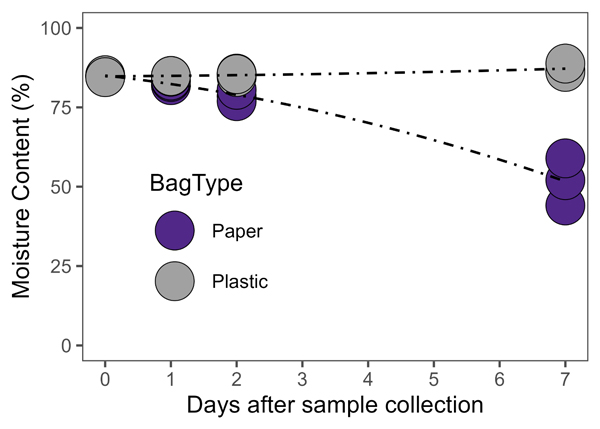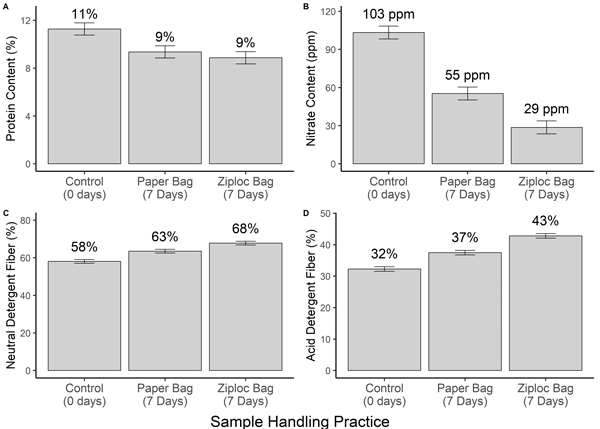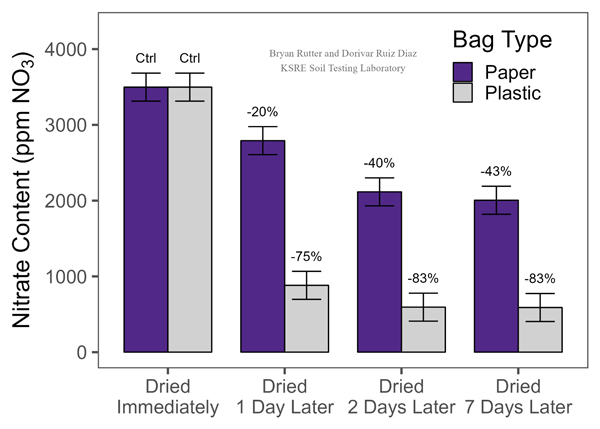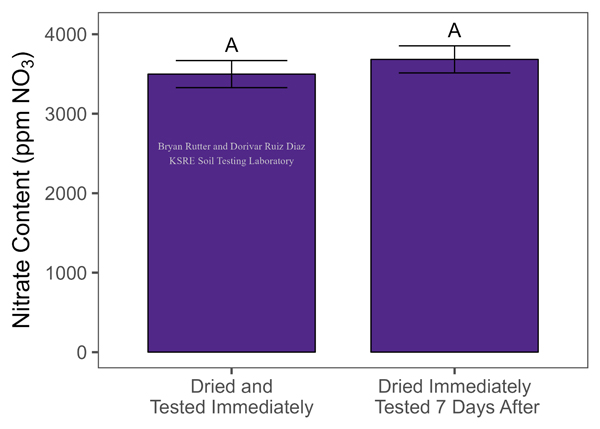Plant tissue analysis is a valuable tool for many applications, including evaluating fertilizer management practices, identifying nutrient deficiencies, and determining hay and forage crops' safety and nutritional value. However, the accuracy of these tests is often limited by the quality of the sample that the laboratory receives.
Much like the soil that plants grow in, many microorganisms exist on the stems and leaves of plants. Many of these microbes actively decompose plant tissue after the growing season. These processes are beneficial for crop production as they drive the nutrient cycling in our fields, but can also lead to skewed test results if they occur in our samples.
A recent study at the KSRE Soil Testing Lab helps to illustrate what can happen if sample submission is delayed. This study compares the effects of storing fresh plant-tissue samples in paper or ziptop-style plastic bags for varying amounts of time (up to 7 days) in the cab of a pickup truck.
Breathable paper bags are usually recommended over plastic bags as they prevent condensation in the samples. However, airflow is also needed to dry fresh plant samples quickly, even if they are stored in paper bags, as can be seen in Figure 1.

Figure 1. Moisture content of plant-tissue samples that were stored in the cab of a pickup truck over 7 days. Purple points indicate paper bags and plastic ziptop-style bags are indicated by grey points. Data and graph by Bryan Rutter, K-State Research and Extension.
Microbial activity affected the results of various tests when samples were not allowed to dry on the same day they were collected. These effects were most notable for the nitrate, protein, acid detergent fiber (ADF), and neutral detergent fiber (NDF) tests (Figure 2). Nitrate contents were reduced rapidly after field collection in undried samples, especially when ziptop plastic bags were used (Figure 3). This can have significant implications for high nitrate forage and potential safety for cattle feeding. When samples are dry, they become stable and can be tested later, showing the same results (Figure 4)

Figure 2. Changes in crude protein (Panel A), nitrate content (Panel B), neutral detergent fiber (Panel C), and Acid Detergent Fiber (Panel D) in whole plant rye samples that were stored in either paper or ziploc-style bags in the cab of a pickup truck for up to seven days after collection. Data and graphs by Bryan Rutter, K-State Research and Extension.

Figure 3. Nitrate content of fresh corn plant samples stored in the cab of a pickup truck for up to seven days. Paper sample bags are indicated by the purple bars, and ziploc-style plastic bags are indicated by the grey bars. The percent difference from the control (“Dried Immediately”) is also indicated. Data and graph by Bryan Rutter, K-State Research and Extension.

Figure 4. Comparison of nitrate content in corn plant samples that were either dried and tested immediately or dried immediately and tested seven days later. Significance letters are also shown indicating no statistical difference between the two groups. This illustrates the stability of nitrate content in plant samples when they are allowed to dry the same day they are collected. Data and graph by Bryan Rutter, K-State Research and Extension.
Take home message
- Sample handling practices can greatly impact the accuracy of test results. This can have significant implications for high nitrate forages and potential safety for cattle feeding.
- Have a plan in place to get samples submitted to the lab as soon as possible, especially when nitrate tests are needed in fresh/actively growing plants.
- If samples cannot be submitted to a lab the same day they are collected, they should be allowed to wilt and air-dry immediately.
- Place undried samples in an open area with good air movement to speed up the drying process.
Bryan Rutter, Doctoral student and K-State Soil Testing Lab Manager
rutter@ksu.edu
Dorivar Ruiz Diaz, Soil Fertility Specialist
ruizdiaz@ksu.edu
Tags: tissue testing sampling nitrates